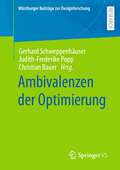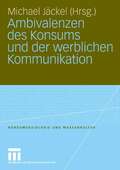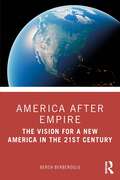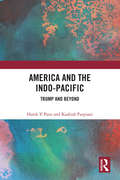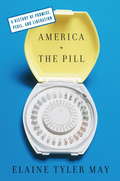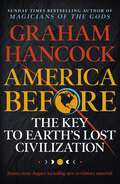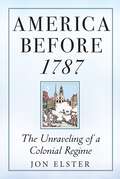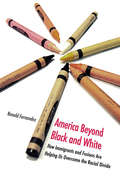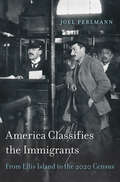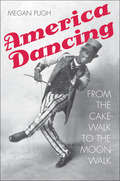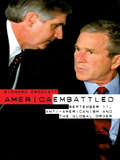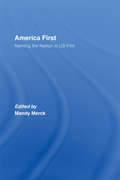- Table View
- List View
Ambivalenzen der Optimierung (Würzburger Beiträge zur Designforschung)
by Gerhard Schweppenhäuser Judith-Frederike Popp Christian BauerInnovation, Wachstum und Optimierung sind normative Grundlagen des Designs, der Technologie, der Wirtschaft, der Gesellschaft und der Kultur. Unter dem Vorzeichen der Digitalisierung zeichnen sich neue ›Optima‹ ab, in denen Menschen zum Bestandteil entgrenzter Netzwerkstrukturen werden. Die in Würzburg entstandenen Aufsätze des vorliegenden Bandes gehen ambivalenten Aspekten dieser Entwicklung mit wissenschaftlichen und gestalterischen Methoden nach. Der Gastbeitrag geht der Frage nach, was dialektisches Denken in Diskurs und Praxis der Gestaltung bedeutet.
Ambivalenzen des Konsums und der werblichen Kommunikation (Konsumsoziologie und Massenkultur)
by Michael JäckelSeit ihren Anfängen wird die Konsumgesellschaft von einer „tiefen Ambivalenz, manchmal sogar offenen Feindschaft gegenüber dem Phänomen des Konsums“ begleitet. Diese Einschätzung eines britischen Konsumforschers scheint nach wie vor zutreffend zu sein. Das Schwanken zwischen Zustimmung und Ablehnung, die Wertschätzung von Wohlstandsgütern bei gleichzeitiger Skepsis gegenüber ihrer permanenten Zurschaustellung und Bewerbung, die Begeisterung für Marken trotz des Wissens um unehrliche Kosten, all diese Widersprüche erlebt der Konsument vor dem Hintergrund einer wachsenden Produktvielfalt, die selbst wiederum gelegentlich als Überforderung eingestuft wird. Die in diesem Buch versammelten Beiträge gehen diesen Ambivalenzen nach und geben Einblicke in historische und aktuelle Kontroversen um den Stellenwert des Konsums aus soziologischer und kommunikationswissenschaftlicher Sicht.
Ambivalenzen von Maske: Ein Brückenschlag von Dietrich Bonhoeffers Theologie in die Popkultur (pop.religion: lebensstil – kultur – theologie)
by Jonathan Frommann-BrecknerEine Maske kann theologisch als ein Phänomen der Ambivalenz verstanden werden. Einerseits kann sie etwas zeigen, indem sie etwas anderes verdeckt. Andererseits kann sie etwas zeigen, was sonst verdeckt bleiben würde. Diese Unterscheidung lässt sich auf maskenähnliche Aspekte des Verhaltens von Menschen übertragen. Menschliches Verhalten kann zum Beispiel zwischen Zeigen und Verdecken, Aufrichtigkeit und Verstellung, Selbstausdruck und Selbstschutz oder Enthüllung und Verhüllung oszillieren. Vor diesem Hintergrund lässt sich eine Idee davon entwickeln, was es bedeuten kann, hinter eine Maske zu sehen oder etwas in einer Maske zu sehen. Dieser phänomenologische Fokus dient als Lektürebrille für Dietrich Bonhoeffers Werk – schwerpunktmäßig für Texte aus den Lebensphasen seiner Konspiration und Haft, in denen eine Theologie der Maske ausgemacht werden kann. Diese Theologie eignet sich als Aufhänger, Vergleichspunkt und Interpretament für die Auseinandersetzung mit Popkultur. Ein solcher theologischer Brückenschlag wird in Bezug auf Quentin Tarantinos Film Inglourious Basterds sowie Selfies im Rahmen von Social Media erprobt.
Ambulatory Surgery Center Safety Guidebook: Managing Code Requirements for Fire and Life Safety
by Dale LymanAmbulatory Surgery Center Safety Guidebook: Managing Code Requirements for Fire and Life Safety helps guide ASC administrative and security staff meet the requirements and standards of both federal and state authorities, including the Life Safety Code, a critical designation for facilities participating in Medicare (CMS) funding reimbursement. Designed for easy reference, the book assumes no code knowledge on the part of ASC staff, and provides guidance for the policies, emergency plans, drills, inspection, testing and maintenance of fire protection and building systems necessary for meeting Life Safety Code requirements. Through sample checklists and log sheets, and a systematic process for completing required documentation, the reader is directed through the crucial steps to achieving code compliance. The guide provides ASC staff the knowledge necessary to be in compliance with the Life Safety Code without the need for an outside security or safety consultant. Through this compliance, facilities remain licensed and qualified for Medicare reimbursement, ultimately improving the financial success of the ASC. - Illuminates the requirements of the Life Safety Code for ASCs for medical and other administrative staff who possess no code knowledge in the ASC setting - Includes compliance requirements for the code, as well as requirements placed upon facilities desiring to participate in Medicare (CMS) funding reimbursement - Provides sample checklists and log sheets for each type of system - Outlines a systematic process for completing the documentation required of ASCs for inspection, testing and maintenance of facility systems crucial to achieving code compliance
America after Empire: The Vision for a New America in the 21st Century
by Berch BerberogluAfter the end of America’s longest (20-year) war in Afghanistan and Iraq that cost more than $6 trillion and nearly half a million lives, what does the future hold for America and the American people in the 21st century? In this timely and important book, Berch Berberoglu provides an eye-opening account of the history of the American Empire from its inception to the present, with prospects for its future. Examining the worldwide expansion of the American Empire over the course of its turbulent history in great detail, Berberoglu assesses America’s imperial legacy in a sober way, highlighting its failure to come to terms with the enormous cost of this adventure in imperial overreach. But Berberoglu sees light at the end of the long, dark tunnel, when the American people will awaken and lead the way to a new America after empire in the coming decades of the 21st century.
America after Empire: The Vision for a New America in the 21st Century
by Berch BerberogluAfter the end of America’s longest (20-year) war in Afghanistan and Iraq that cost more than $6 trillion and nearly half a million lives, what does the future hold for America and the American people in the 21st century? In this timely and important book, Berch Berberoglu provides an eye-opening account of the history of the American Empire from its inception to the present, with prospects for its future. Examining the worldwide expansion of the American Empire over the course of its turbulent history in great detail, Berberoglu assesses America’s imperial legacy in a sober way, highlighting its failure to come to terms with the enormous cost of this adventure in imperial overreach. But Berberoglu sees light at the end of the long, dark tunnel, when the American people will awaken and lead the way to a new America after empire in the coming decades of the 21st century.
America and the British Imaginary in Turn-of-the-Twentieth-Century Literature
by B. MillerIn an innovative reading of fin-de-siecle cultural texts, Miller argues that British representations of America, Americans, and Anglo-American relations at the turn of the twentieth century provided an important forum for cultural distinction.
America and the Indo-Pacific: Trump and Beyond
by Harsh Pant Kashish ParpianiThis book offers an extensive account of Donald Trump’s foreign policy record in the Indo-Pacific region. Set against the backdrop of Trump’s policy of sustained US confrontation with China, it recounts his administration’s efforts to shore up America’s position with the Indo-Pacific strategy. It also reviews Trump’s record with allies and partners in the Indo-Pacific and the South Asian subregion in context of the ‘great power competition’ between China and the United States. Amidst the ongoing conversations on the declining currency of American internationalism, the volume showcases the seeming insularity of the Indo-Pacific region from forces that are informing an America in retreat. In noting Trump’s record to have been a consequential one, the authors also offer insights into the prospects for US policy continuity under Joe Biden. This timely book will be of great interest to scholars, teachers and students of politics and international relations, Asia studies, US-China studies, area studies, foreign policy, maritime studies, and world politics. It is a recommended read for all watchers of US foreign policy and the evolving US-China rivalry.
America and the Indo-Pacific: Trump and Beyond
by Harsh Pant Kashish ParpianiThis book offers an extensive account of Donald Trump’s foreign policy record in the Indo-Pacific region. Set against the backdrop of Trump’s policy of sustained US confrontation with China, it recounts his administration’s efforts to shore up America’s position with the Indo-Pacific strategy. It also reviews Trump’s record with allies and partners in the Indo-Pacific and the South Asian subregion in context of the ‘great power competition’ between China and the United States. Amidst the ongoing conversations on the declining currency of American internationalism, the volume showcases the seeming insularity of the Indo-Pacific region from forces that are informing an America in retreat. In noting Trump’s record to have been a consequential one, the authors also offer insights into the prospects for US policy continuity under Joe Biden. This timely book will be of great interest to scholars, teachers and students of politics and international relations, Asia studies, US-China studies, area studies, foreign policy, maritime studies, and world politics. It is a recommended read for all watchers of US foreign policy and the evolving US-China rivalry.
America and the Making of Modern Turkey: Science, Culture and Political Alliances
by Ali ErkenAfter the fall of the Ottoman Empire, Mustafa Kemal Ataturk's government encouraged substantial American investment in education and aid. It was argued that Turkey needed the technical skills and wealth offered by American education, and so a series of American schools was set up across the country to educate the Turkish youth. Here, Ali Erken, in the first study of its kind, argues that these organizations had a huge impact on political and economic thought in Turkey - acting as a form of `soft power' for US national interests throughout the 20th Century. Robert College, originally a missionary school founded by US benefactors, has been responsible for educating two Turkish Prime Ministers, writers such as Orhan Pamuk and a huge number of influential economists, politicians and journalists. The end result of these American philanthropic efforts, Erken argues, was a consensus in the 1970s that the country must `westernize'. This mindset, and the opposition viewpoint it engendered, has come to define political struggle in modern Turkey - torn between a capitalist `modern' West and an Islamic `Ottoman' East. The book also reveals how and why the Rockefeller and Ford foundations funneled large amounts of money into Turkey post-1945, and undertook activities in support of `Western' candidates in Turkey as a bulwark against the Soviet Union. This is an essential contribution to the history of US-Turkish relations, and the influence of the West in Turkish political thought.
America and the Pill: A History of Promise, Peril, and Liberation
by Elaine Tyler MayIn 1960, the FDA approved the contraceptive commonly known as "the pill." Advocates, developers, and manufacturers believed that the convenient new drug would put an end to unwanted pregnancy, ensure happy marriages, and even eradicate poverty. But as renowned historian Elaine Tyler May reveals in America and the Pill, it was women who embraced it and created change. They used the pill to challenge the authority of doctors, pharmaceutical companies, and lawmakers. They demonstrated that the pill was about much more than family planning-it offered women control over their bodies and their lives. From little-known accounts of the early years to personal testimonies from young women today, May illuminates what the pill did and did not achieve during its half century on the market.
America and the Pill: A History of Promise, Peril, and Liberation
by Elaine Tyler MayIn 1960, the FDA approved the oral contraceptive that would come to be known as the pill. Within a few years, millions of women were using it. At a time when the population was surging, many believed that the drug would help eradicate poverty around the globe, ensure happy and stable marriages, and liberate women. In America and the Pill, preeminent social historian Elaine Tyler May reveals the ways in which the pill did and did not fulfill these utopian dreams, while also chronicling the stories of the creators, testers, and users who ultimately made the pill their own.
America and the Rogue States (American Foreign Policy in the 21st Century)
by T. HenriksenAmerica and the Rogue States traces and examines the policies and interaction of the United States with the main adversarial nations in the post-Cold War era. The book concentrates on the three major rogue states-North Korea, Iran, and pre-invasion Iraq. What are termed as lesser rogue nations-Libya, Syria, Cuba, and the Sudan-receive summarized treatment in one chapter together with a brief discussion about why Afghanistan and Venezuela are not rogues. The author makes clear the distinctions among these confrontational regimes, noting that North Korea, Iran, and Saddam Hussein's Iraq aroused much more anxiety in Washington than lesser rogues and other troublesome states. After an opening chapter placing the rogue-nation phenomenon in historical and current context, the manuscript devotes one chapter each to the three major adversarial rogues. A final chapter deals with the less threatening rogue regimes. Each chapter follows a chronological format with description and analysis. The work is intended for a general reader interested in the topic; it also will have appeal as a supplemental text for university classes in international relations covering the period after the Cold War ended.
America Before: A new investigation into the mysteries of the human past by the bestselling author of Fingerprints of the Gods and Magicians of the Gods
by Graham Hancock***THE SUNDAY TIMES TOP TEN BESTSELLER***'Hancock's books provide a fascinating, alternative version of prehistory. America Before, detailed and wide-ranging, turns what was myth and legend into a new story of the past.' Daily Mail Was an advanced civilization lost to history in the global cataclysm that ended the last Ice Age? Graham Hancock, the internationally bestselling author, has made it his life's work to find out -- and in America Before, he draws on the latest archaeological and DNA evidence to bring his quest to a stunning conclusion.We've been taught that North and South America were empty of humans until around 13,000 years ago - amongst the last great landmasses on earth to have been settled by our ancestors. But new discoveries have radically reshaped this long-established picture and we know now that the Americas were first peopled more than 130,000 years ago - many tens of thousands of years before human settlements became established elsewhere.Hancock's research takes us on a series of journeys and encounters with the scientists responsible for the recent extraordinary breakthroughs. In the process, from the Mississippi Valley to the Amazon rainforest, he reveals that ancient 'New World' cultures share a legacy of advanced scientific knowledge and sophisticated spiritual beliefs with supposedly unconnected 'Old World' cultures. Have archaeologists focussed for too long only on the 'Old World' in their search for the origins of civilization while failing to consider the revolutionary possibility that those origins might in fact be found in the 'New World'?America Before: The Key to Earth's Lost Civilisation is the culmination of everything that millions of readers have loved in Hancock's body of work over the past decades, namely a mind-dilating exploration of the mysteries of the past, amazing archaeological discoveries and profound implications for how we lead our lives today.
America before 1787: The Unraveling of a Colonial Regime
by Jon ElsterAn original account, drawing on both history and social science, of the causes and consequences of the American RevolutionWith America before 1787, Jon Elster offers the second volume of a projected trilogy that examines the emergence of constitutional politics in France and America. Here, he explores the increasingly uneasy relations between Britain and its American colonies and the social movements through which the thirteen colonies overcame their seemingly deep internal antagonisms.Elster documents the importance of the radical uncertainty about their opponents that characterized both British and American elites and reveals the often neglected force of enthusiasm, and of emotions more generally, in shaping beliefs and in motivating actions. He provides the first detailed examinations of &“divide and rule&” as a strategy used on both sides of the Atlantic and of the rise and fall of collective action movements among the Americans. Elster also explains how the gradual undermining in America of the British imperial system took its toll on transatlantic relations and describes how state governments and the American Confederation made crucial institutional decisions that informed and constrained the making of the Constitution.Drawing on a wide range of historical sources and on theories of modern social science, Elster brings together two fields of scholarship in innovative and original ways. The result is a unique synthesis that yields new insights into some of the most important events in modern history.
America Behind The Color Line: Dialogues with African Americans
by Henry Louis GatesRenowned scholar and "New York Times" bestselling author Gates delivers a stirring and authoritative companion to the major new PBS documentary "America Behind the Color Line." The book includes thought-provoking essays from Colin Powell, Morgan Freeman, Russell Simmons, Vernon Jordan, Alicia Keys, Bernie Mac, and Quincy Jones.
America Beyond Black and White: How Immigrants and Fusions Are Helping Us Overcome the Racial Divide (Contemporary Political And Social Issues)
by Ronald Fernandez“This book is both powerful and important. Powerful for the testimony it provides from Americans of many different (and even mixed races) about their experiences. And important because there is a racial revolution underway that will upend race as we know it during the twenty-first century.” —John Kenneth White, Catholic University of America America Beyond Black and White is a call for a new way of imagining race in America. For the first time in U.S. history, the black-white dichotomy that has historically defined race and ethnicity is being challenged, not by a small minority, but by the fastest-growing and arguably most vocal segment of the increasingly diverse American population—Mexicans, Chinese, Japanese, Koreans, Indians, Arabs, and many more—who are breaking down and recreating the very definitions of race. Drawing on interviews with hundreds of Americans who don’t fit conventional black/white categories, the author invites us to empathize with these “doubles” and to understand why they may represent our best chance to throw off the strictures of the black/white dichotomy. The revolution is already underway, as newcomers and mixed-race “fusions” refuse to engage in the prevailing Anglo- Protestant culture. Americans face two choices: understand why these individuals think as they do, or face a future that continues to define us by what divides us rather than by what unites us.
An America Challenged: Population Change And The Future Of The United States
by Steve H MurdockPopulation Change And The Future Of The United States
An America Challenged (PDF): Population Change and the Future of the United States (PDF)
by Steve H MurdockThis study looks at the implications of demographic changes in the USA for business, government and the public. Using up-to-date census information, the author provides a brief historical overview of recent demographic change in the USA.
America Classifies the Immigrants: From Ellis Island to the 2020 Census
by Joel Perlmann PerlmannWhen more than twenty million immigrants arrived in the United States between 1880 and 1920, the government attempted to classify them according to prevailing ideas about race and nationality. But this proved hard to do. Ideas about racial or national difference were slippery, contested, and yet consequential—were “Hebrews” a “race,” a “religion,” or a “people”? As Joel Perlmann shows, a self-appointed pair of officials created the government’s 1897 List of Races and Peoples, which shaped exclusionary immigration laws, the wording of the U.S. Census, and federal studies that informed social policy. Its categories served to maintain old divisions and establish new ones. Across the five decades ending in the 1920s, American immigration policy built increasingly upon the belief that some groups of immigrants were desirable, others not. Perlmann traces how the debates over this policy institutionalized race distinctions—between whites and nonwhites, but also among whites—in immigration laws that lasted four decades. Despite a gradual shift among social scientists from “race” to “ethnic group” after the 1920s, the diffusion of this key concept among government officials and the public remained limited until the end of the 1960s. Taking up dramatic changes to racial and ethnic classification since then, America Classifies the Immigrants concentrates on three crucial reforms to the American Census: the introduction of Hispanic origin and ancestry (1980), the recognition of mixed racial origins (2000), and a rethinking of the connections between race and ethnic group (proposed for 2020).
America Classifies the Immigrants: From Ellis Island to the 2020 Census
by Joel Perlmann PerlmannWhen more than twenty million immigrants arrived in the United States between 1880 and 1920, the government attempted to classify them according to prevailing ideas about race and nationality. But this proved hard to do. Ideas about racial or national difference were slippery, contested, and yet consequential—were “Hebrews” a “race,” a “religion,” or a “people”? As Joel Perlmann shows, a self-appointed pair of officials created the government’s 1897 List of Races and Peoples, which shaped exclusionary immigration laws, the wording of the U.S. Census, and federal studies that informed social policy. Its categories served to maintain old divisions and establish new ones. Across the five decades ending in the 1920s, American immigration policy built increasingly upon the belief that some groups of immigrants were desirable, others not. Perlmann traces how the debates over this policy institutionalized race distinctions—between whites and nonwhites, but also among whites—in immigration laws that lasted four decades. Despite a gradual shift among social scientists from “race” to “ethnic group” after the 1920s, the diffusion of this key concept among government officials and the public remained limited until the end of the 1960s. Taking up dramatic changes to racial and ethnic classification since then, America Classifies the Immigrants concentrates on three crucial reforms to the American Census: the introduction of Hispanic origin and ancestry (1980), the recognition of mixed racial origins (2000), and a rethinking of the connections between race and ethnic group (proposed for 2020).
America Dancing: From the Cakewalk to the Moonwalk
by Megan PughThe history of American dance reflects the nation’s tangled culture. Dancers from wildly different backgrounds learned, imitated, and stole from one another. Audiences everywhere embraced the result as deeply American. Using the stories of tapper Bill "Bojangles" Robinson, Ginger Rogers and Fred Astaire, ballet and Broadway choreographer Agnes de Mille, choreographer Paul Taylor, and Michael Jackson, Megan Pugh shows how freedom—that nebulous, contested American ideal—emerges as a genre-defining aesthetic. In Pugh’s account, ballerinas mingle with slumming thrill-seekers, and hoedowns show up on elite opera house stages. Steps invented by slaves on antebellum plantations captivate the British royalty and the Parisian avant-garde. Dances were better boundary crossers than their dancers, however, and the issues of race and class that haunt everyday life shadow American dance as well. Deftly narrated, America Dancing demonstrates the centrality of dance in American art, life, and identity, taking us to watershed moments when the nation worked out a sense of itself through public movement.
America Embattled: September 11, Anti-americanism, and the Global Order (PDF)
by Richard CrockattWhat causes Anti- Americanism and where are its historical roots? What is the impact of 9/11 on America's sense of itself and its role in the world? Is America paradoxically a victim of its own political and economic power? This book seeks to understand the terrible attacks of September 11th within a broader historical, political and ideological context. Rather than drawing on simple 'clash of civilisation' oppositions, the author argues that it is important to have an awareness of the complex historical processes which influence: America's sense of itself and its changing view of the world How the world, especially the Muslim world, views America The changing nature of international politics and the global system since the end of the cold war. Drawing on a wide range of contemporary and historical sources Richard Crockatt has written a balanced, subtle and highly readable book which provides genuine insight into American foreign policy, anti-Americanism and Islamic fundamentalism. It will be important reading for all those seeking to understand the background to the 'war on terror'.
America Embattled: September 11, Anti-americanism, And The Global Order
by Richard CrockattWhat causes Anti- Americanism and where are its historical roots? What is the impact of 9/11 on America's sense of itself and its role in the world? Is America paradoxically a victim of its own political and economic power? This book seeks to understand the terrible attacks of September 11th within a broader historical, political and ideological context. Rather than drawing on simple 'clash of civilisation' oppositions, the author argues that it is important to have an awareness of the complex historical processes which influence: America's sense of itself and its changing view of the world How the world, especially the Muslim world, views America The changing nature of international politics and the global system since the end of the cold war. Drawing on a wide range of contemporary and historical sources Richard Crockatt has written a balanced, subtle and highly readable book which provides genuine insight into American foreign policy, anti-Americanism and Islamic fundamentalism. It will be important reading for all those seeking to understand the background to the 'war on terror'.
America First: Naming the Nation in US Film
by Mandy MerckAt a time when the expanded projection of US political, military, economic and cultural power draws intensified global concern, understanding how that country understands itself seems more important than ever. This collection of new critical essays tackles this old problem in a new way, by examining some of the hundreds of US films that announce themselves as titularly 'American'. From early travelogues to contemporary comedies, national nomination has been an abiding characteristic of American motion pictures, heading the work of Porter, Guy-Blaché, DeMille, Capra, Sternberg, Vidor, Minnelli and Mankiewicz. More recently, George Lucas, Paul Schrader, John Landis and Edward James Olmos have made their own contributions to Hollywood’s Americana. What does this national branding signify? Which versions of Americanism are valorized, and which marginalized or excluded? Out of which social and historical contexts do they emerge, and for and by whom are they constructed? Edited by Mandy Merck, the collection contains detailed analyses of such films as The Vanishing American, American Madness, An American in Paris, American Graffiti, American Gigolo, American Pie and many more.
